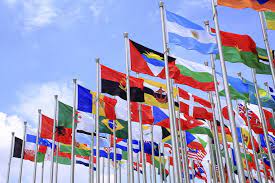
Challenges of coordinating Indian Foreign Policy with Neighboring countries
Challenges of coordinating Indian Foreign Policy with Neighboring countries
Important for Prelims:
Non-Aligned Movement, 'Neighborhood First' Policy, Act East Policy, Vaccine Diplomacy, Gujral Doctrine, Panchsheel Doctrine, SAARC, Operation Cactus
Important for Mains:
GS-2: Stages of evolution of India's foreign policy, challenges, various initiatives to improve cordial relations with neighboring countries, way forward
December 13, 2023
Context:
At present the biggest challenge before Indian foreign policy lies in its relations with neighboring countries. India has set ambitious goals of becoming a leading nation in the global south, a mediator in global geopolitical conflicts and an important actor in world politics.
- In this context, India is facing obstacles from its own neighboring countries. Unlike other major powers, India faces complex situations in South Asia.
- Such a situation has become even more complicated due to an emerging superpower in the region. Although India aims for regional cooperation, neighboring countries appear to be hesitant in fully adopting India's vision, indirectly hindering its aspirations.
Stages of development of India's foreign policy
- From the British era to 1950, Indian foreign policy was influenced by British interests. Bhutan ceded its strategic passes to the British, but retained its autonomy. Nepal's independent status ended with the Treaty of Sagauli in 1816 in favor of the British. Burma came under control in 1885 due to the Anglo-Burmese Wars.
- Indian foreign policy in the 1950s and 1960s was inspired by idealism. India's foreign policy under the first Prime Minister Jawaharlal Nehru adopted the Non-Aligned Movement (NAM) and the Panchsheel principles with China but the India-China war of 1962 prompted a reassessment of relations. The India-Pakistan war of 1965 further increased tensions.
- In Indian foreign policy during 1970 to 1980, India adopted the foreign policy of realism from idealism. During this period, India displayed a more assertive foreign policy, intervening in the Bangladesh Liberation War in 1971. SAARC was formed in 1985 for regional cooperation. The India-Sri Lanka Accord of 1987 addressed the Sri Lankan civil war and Operation Cactus in 1988 foiled a coup in the Maldives.
- After the Cold War, India emphasized economic development in its foreign policy in the context of changed global circumstances and further strengthened its relations with Western countries. Similarly, India's 'Look East' policy (1991) was aimed at strengthening relations with South East Asian countries. The Gujral Doctrine (1996) emphasized non-reciprocity, non-interference and peaceful dispute resolution with neighbours. BIMSTEC (1997) and IORA (1997) promoted regional cooperation.
Challenges facing Indian foreign policy:
Rise of anti-India systems:
- A politically anti-India regime has been established in Maldives and the government there is urging Indian citizens to leave from there. This is a direct challenge before India.
- Additionally, there is a growing possibility of a Khaleda Zia-led government being formed in Dhaka, which is ideologically opposed to India, which may further complicate matters for India.
Structural dilemmas due to Beijing's influence:
- China's growing influence in South Asia, especially through the Belt and Road Initiative (BRI), is complicating India's regional position. Beijing's outreach to smaller states often bypasses accepted standard views in international politics.
Changing geopolitical scenario:
- China is attempting to fill the power vacuum that has developed with the declining presence of the United States in the changing regional geopolitical scenario.
Causes of India's dilemma:
Regional Geopolitics:
- The declining presence of the United States in South Asia has created a power vacuum. The aggressive rise of China is acting as a geopolitical buffer for smaller states, providing them an alternative to India.
Policy Stances and Beliefs:
- Generally, India's policy focuses only on the people in power in its neighboring countries, due to which other power centers get isolated, which creates a dilemma for India in the changed circumstances. In light of emerging geopolitical realities, it is questionable to believe that cultural and historical ties will naturally lead to better relations.
Various initiatives to improve cordial relations with neighboring countries:
'Neighbourhood First' Policy:
- This policy emphasizes mutual respect, understanding and sensitivity to address the concerns and priorities of neighboring countries.
- Launched in 2014, the policy aims to enhance relations with South Asian and Indian Ocean countries with an emphasis on regional cooperation and development.
Act East Policy:
- This initiative focuses on strengthening ties with Southeast Asian and Asia-Pacific countries to enhance regional cooperation.
Connectivity Initiative:
- India is actively promoting connectivity through projects such as the International North-South Transport Corridor, Chabahar Port in Iran and Kaladan Multimodal Transit Transport Project in Myanmar.
Developmental Cooperation:
- India is providing development assistance through programs such as Technical, Economic Cooperation (ITEC) program and Indian Council for Cultural Relations (ICCR).
Way Forward:
- India needs to implement a comprehensive and strategic approach to address the challenges faced by its neighboring countries.
- India must re-evaluate its traditional beliefs and policies due to the rise of anti-India regimes, China's growing influence and changing regional dynamics.
- India needs adaptability, innovation and change in historical patterns to secure its position in the changing geopolitical scenario.
Conclusion:
- Acknowledging changed realities, actively engaging external actors, adopting flexible diplomacy and overcoming the constraints of diplomatic resources are important steps for India to successfully resolve dilemmas in its neighbourhood. In matters of national interest, both the ruling party and the opposition should remain strategically united so that a strong image of India can emerge at the international level.
Source: Jansatta
-------------------------------------
Mains Question
Analyze the historical changes in India's foreign policy with its neighbors and the challenges posed by its implications.